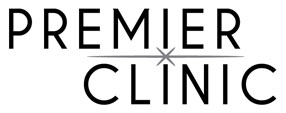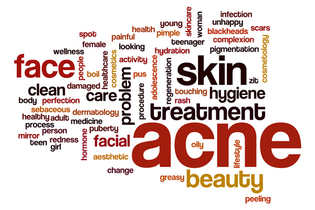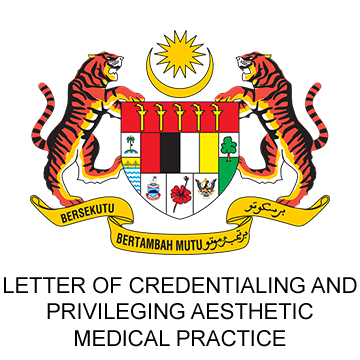Definition
Acne is a skin condition that occurs when your hair follicles become plugged with oil and dead skin cells. Acne usually appears on your face, neck, chest, back and shoulders. Effective treatments are available, but acne can be persistent. The pimples and bumpshttps://www.klaesthetic.com/wp-admin/post-new.php heal slowly, and when one begins to go away, others seem to crop up.
Acne is most common among teenagers, with a reported prevalence of 70 to 87 percent. Increasingly, younger children are getting acne as well.
Depending on its severity, acne can cause emotional distress and scar the skin. The earlier you start treatment, the lower your risk of lasting physical and emotional damage.
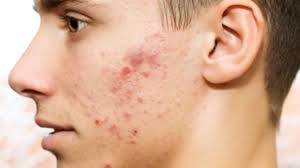
Face Acne
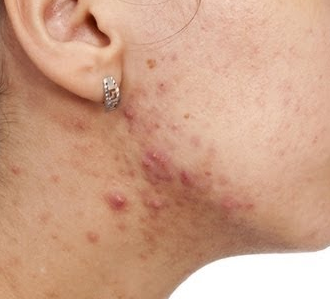
Neck Acne
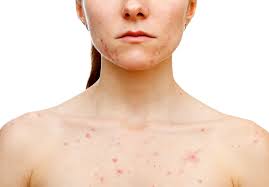
Chest Acne
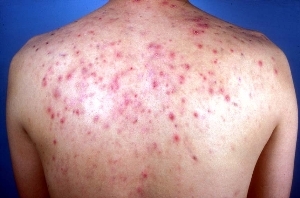
Back Acne
Symptoms
Acne signs and symptoms vary depending on the severity of your condition:
- Whiteheads (closed plugged pores)
- Blackheads (open plugged pores — the oil turns brown when it is exposed to air)
- Small red, tender bumps (papules)
- Pimples (pustules), which are papules with pus at their tips
- Large, solid, painful lumps beneath the surface of the skin (nodules)
- Painful, pus-filled lumps beneath the surface of the skin (cystic lesions)
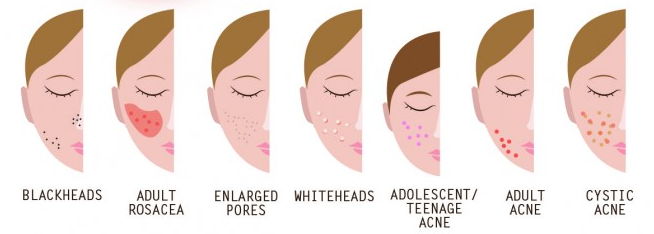
Causes
Four main factors cause acne:
- Oil production
- Dead skin cells
- Clogged pores
- Bacteria

Factors that may worsen acne
These factors can trigger or aggravate an existing case of acne:
- Hormones. Androgens are hormones that increase in boys and girls during puberty and cause the sebaceous glands to enlarge and make more sebum. Hormonal changes related to pregnancy and the use of oral contraceptives also can affect sebum production. And low amounts of androgens circulate in the blood of women and can worsen acne.
- Certain medications. Drugs containing corticosteroids, androgens or lithium can worsen acne.
- Diet. Studies indicate that certain dietary factors, including dairy products and carbohydrate-rich foods — such as bread, bagels and chips — may trigger acne. Chocolate has long been suspected of making acne worse. A recent study of 14 men with acne showed that eating chocolate was related to an increase in acne. Further study is needed to examine why this happens or whether acne patients need to follow specific dietary restrictions.
- Stress. Stress can make acne worse.
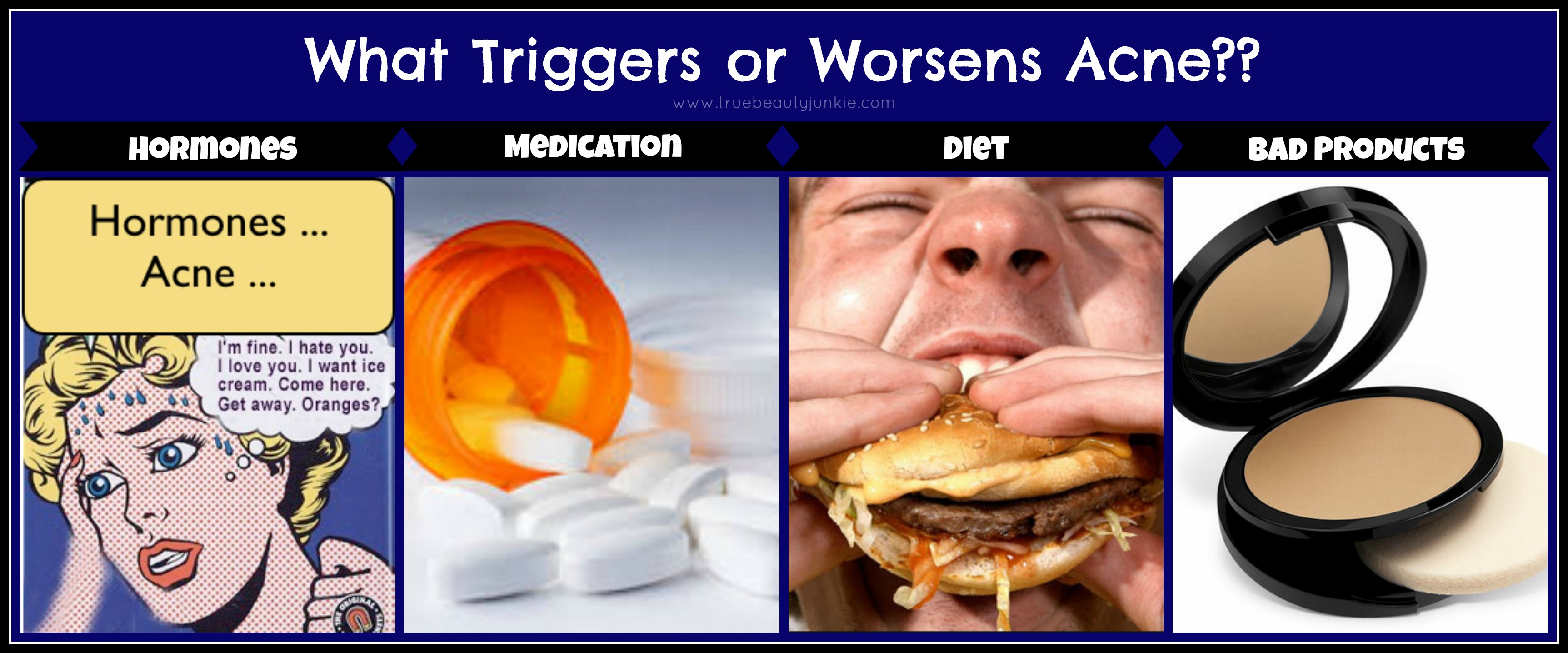
Acne myths
These factors have little effect on acne:
- Greasy foods. Eating greasy food has little to no effect on acne. Though working in a greasy area, such as a kitchen with fry vats, does because the oil can stick to the skin and block the hair follicles. This further irritates the skin or promotes acne.
- Dirty skin. Acne isn’t caused by dirt. In fact, scrubbing the skin too hard or cleansing with harsh soaps or chemicals irritates the skin and can make acne worse. Though it does help to gently remove oil, dead skin and other substances.
- Cosmetics. Cosmetics don’t necessarily worsen acne, especially if you use oil-free makeup that doesn’t clog pores (noncomedogenics) and remove makeup regularly. Non oily cosmetics don’t interfere with the effectiveness of acne drugs.
Treatments and drugs
If over-the-counter (nonprescription) products haven’t cleared up your acne, your doctor can prescribe stronger medications or other therapies. A dermatologist can help you:
- Control your acne
- Avoid scarring or other damage to your skin
- Make scars less noticeable
Acne medications work by reducing oil production, speeding up skin cell turnover, fighting bacterial infection or reducing inflammation — which helps prevent scarring. With most prescription acne drugs, you may not see results for four to eight weeks, and your skin may get worse before it gets better. It can take many months or years for your acne to clear up completely.
The drug your doctor recommends depends on the type and severity of your acne. It might be something you apply to your skin (topical medication) or take by mouth (oral medication). Often, drugs are used in combination. Pregnant women will not be able to use oral prescription medications for acne.
Talk with your doctor about the risks and benefits of medications and other treatments you are considering.
Topical medications
These products work best when applied to clean, dry skin about 15 minutes after washing. You may not see the benefit of this treatment for a few weeks. And you may notice skin irritation at first, such as redness, dryness and peeling.
Your doctor may recommend steps to minimize these side effects, including using a gradually increased dose, washing off the medication after a short application or switching to another medication.
The most common topical prescription medications for acne are:
- Retinoids. These come as creams, gels and lotions. Retinoid drugs are derived from vitamin A and include tretinoin (Avita, Retin-A, others), adapalene (Differin) and tazarotene (Tazorac, Avage). You apply this medication in the evening, beginning with three times a week, then daily as your skin becomes used to it. It works by preventing plugging of the hair follicles.
- Antibiotics. These work by killing excess skin bacteria and reducing redness. For the first few months of treatment, you may use both a retinoid and an antibiotic, with the antibiotic applied in the morning and the retinoid in the evening. The antibiotics are often combined with benzoyl peroxide to reduce the likelihood of developing antibiotic resistance. Examples include clindamycin with benzoyl peroxide (Benzaclin, Duac, Acanya) and erythromycin with benzoyl peroxide (Benzamycin).
- Dapsone (Aczone). This gel is most effective when combined with a topical retinoid. Skin side effects include redness and dryness.
Oral medications
- Antibiotics. For moderate to severe acne, you may need oral antibiotics to reduce bacteria and fight inflammation. Choices for treating acne include tetracyclines, such as minocycline and doxycycline.
- Your doctor likely will recommend tapering off these medications as soon as your symptoms begin to improve or as soon as it becomes clear the drugs aren’t helping — usually, within three to four months. Tapering helps prevent antibiotic resistance by minimizing undue exposure to these medications over a long time.You will likely use topical medications and oral antibiotics together. Studies have found that using topical benzoyl peroxide along with oral antibiotics may reduce the risk of developing antibiotic resistance.
Antibiotics may cause side effects, such as an upset stomach and dizziness. These drugs also increase your skin’s sun sensitivity. They can cause discoloration of developing permanent teeth and reduced bone growth in children born to women who took tetracyclines while pregnant.
- Combined oral contraceptives. Combined oral contraceptives are useful in treating acne in women and adolescent girls. The Food and Drug Administration approved three products that combine estrogen and progestin (Ortho Tri-Cyclen, Estrostep and Yaz).The most common side effects of these drugs are headache, breast tenderness, nausea, weight gain and breakthrough bleeding. A serious potential complication is a slightly increased risk of blood clots.
- Anti-androgen agent. The drug spironolactone (Aldactone) may be considered for women and adolescent girls if oral antibiotics aren’t helping. It works by blocking the effect of androgen hormones on the sebaceous glands. Possible side effects include breast tenderness, painful periods and the retention of potassium.
- Isotretinoin. This medicine is reserved for people with the most severe acne. Isotretinoin (Amnesteem, Claravis, Sotret) is a powerful drug for people whose acne doesn’t respond to other treatments.Oral isotretinoin is very effective. But because of its potential side effects, doctors need to closely monitor anyone they treat with this drug. The most serious potential side effects include ulcerative colitis, an increased risk of depression and suicide, and severe birth defects.
In fact, isotretinoin carries such serious risk of side effects that women of reproductive age must participate in a Food and Drug Administration-approved monitoring program to receive a prescription for the drug.
Therapies
These therapies may be suggested in select cases, either alone or in combination with medications.
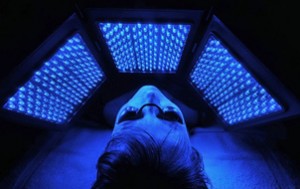
Light therapy. A variety of light-based therapies have been tried with success. But further study is needed to determine the ideal method, light source and dose. Light therapy targets the bacteria that cause acne inflammation. Some types of light therapy are done in a doctor’s office. Blue-light therapy can be done at home with a hand-held device.Possible side effects of light therapy include pain, temporary redness and sensitivity to sunlight.
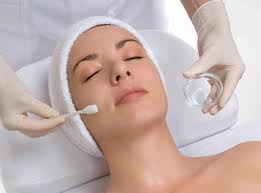
Chemical peel. This procedure uses repeated applications of a chemical solution, such as salicylic acid. It is most effective when combined with other acne treatments, except oral retinoids. Chemical peels aren’t recommended for people taking oral retinoids because together these treatments can significantly irritate the skin.
Chemicals peels may cause temporary, severe redness, scaling and blistering, and long-term discoloration of the skin.
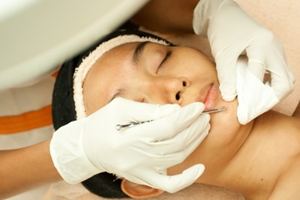
Extraction of whiteheads and blackheads. Your dermatologist uses special tools to gently remove whiteheads and blackheads (comedons) that haven’t cleared up with topical medications. This technique may cause scarring.
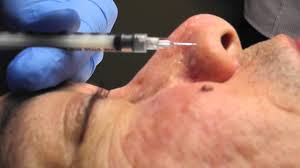
Steroid injection. Nodular and cystic lesions can be treated by injecting a steroid drug directly into them. This improves their appearance without the need for extraction. The side effects of this technique include thinning of the skin, lighter skin and the appearance of small blood vessels on the treated area.
Treating acne scars
Procedures used to diminish scars left by acne include the following:
- Soft tissue fillers. Injecting soft tissue fillers, such as collagen or fat, under the skin and into indented scars can fill out or stretch the skin. This makes the scars less noticeable. Results are temporary, so you would need to repeat the injections periodically. Side effects include temporary swelling, redness and bruising.
- Chemical peels. High-potency acid is applied to your skin to remove the top layer and minimize deeper scars.
- Light therapy. Certain lasers, pulsed light sources and radiofrequency devices that don’t injure the epidermis can be used to treat scars. These treatments heat the dermis and cause new skin to form. After several treatments, acne scars may appear less noticeable. This treatment has shorter recovery times than some other methods. But you may need to repeat the procedure more often and results are subtle.
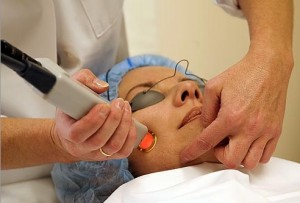
Laser resurfacing. This is a skin resurfacing procedure that uses a laser to improve the appearance of your skin.
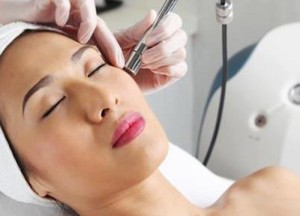
Dermabrasion. This procedure is usually reserved for more severe scarring. It involves sanding (planing) the surface layer of skin with a rotating brush. This helps blend acne scars into the surrounding skin.
Coping and support

- Acne and the scars it can cause may affect your social relationships and self-esteem. Sometimes it can help to talk with your family, a support group or a counselor. Call Premier Clinic today for FREE CONSULTATION with our experienced doctors at 0126625552.

